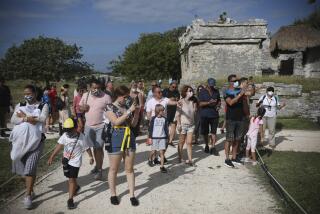Mexico Charms Tourists With New Adventures
- Share via
Mexico, like a vintage Humphrey Bogart movie, frequently fulfills a longing for both adventure and discovery. I know--because it’s my beat.
One of the few countries with a comprehensive program to develop tourism in new and existing tourist zones, Mexico offers a selection of learning endeavors in a trend that is here to stay.
East Coast
Visitors can follow the path of intriguing pre-Columbian civilizations to areas that remain curiously unknown.
A timelessness in the state of Veracruz is seen in the rich archeological ruins, cozy open-air restaurants and in Veracruzano music.
From Tampico south to Isla del Carmen via Highway 180, which skirts the coast, people go about their lives as they have for hundreds of years, tending their fields, selling and buying at market and fishing the Gulf of Mexico.
Villages show a pastoral setting that has never failed to charm Mexican poets. Travelers can shoot basketballs with town folks in a plaza that the Mayans might have trod, watch a baseball game where center field is filled with grazing cows, and join a wedding, kiss the bride and feast on local delicacies.
Five miles west of Papantla and 120 miles northwest of Veracruz rise the spectacular 2,500-acre El Tajin ruins, circa AD 600, one of Mexico’s most important and least-visited archeological sites.
Surrounding the El Tajin pyramids are vanilla and tobacco plantations and the famed pepper fields that produce the delicious jalapenos used in the Pace Foods picante sauce.
Welcoming Inhabitants
Indians, shy but friendly, wearing classic white straw hats and boots with pointed toes, will shake your hand and smile as they head to market with their crops. In the evening you can eat Chipotle, a smoked and saucy jalapeno, while the rich scent of peppers wafts across the countryside.
In Veracruz, the oldest colonial city in Mexico, far removed from the tourist trail, browse through San Juan de Ulua Spanish fortress/prison, the first built in the Western Hemisphere and one of the best preserved.
Standing in the tower looking at the moats, dungeons, cannons and draw bridges, it’s easy to imagine the gold-laden galleons sailing out on their way to Cadiz, Spain.
The zocalo is lined with colonial buildings and a block-long maze of 10 sidewalk cafe/bars, home of exciting marimba musicians and mariachi bands with trumpet players who can rattle the coconuts in the towering palms.
The party, which begins at noon and lasts till the wee hours, rivals the Plaza de los Mariachis in Guadalajara and Garibaldi Square in Mexico City.
Well Known Arts Center
Inland and south, Oaxaca, a crafts center, is proud of its hand-loomed textiles and popular black Coyotepec pottery. On Saturdays the Indians sell serapes and wares at a colorful market that is a traveler’s highlight in this part of the world.
Delve into Oaxaca’s regional art galleries, the Rufino Tamayo Museum and the spectacular National Museum that houses jewelry and treasures excavated from nearby Monte Alban, a Zapotec city dating to 800 BC.
At Mitla, 24 miles south and one of the few ancient cities occupied at the time of the Spanish conquest, hard-working Indian women still weave with wooden frames and shuttle. The lonely and isolated ruins consist of stone temples, underground chambers and unusual stone wall carvings.
Yucatan Peninsula
At Cancun, one of Mexico’s most popular resort destinations, windsurfers skim across the water like roadrunners, and snorkeling, scuba diving and fishing are a way of life.
Lingering sunsets, 240-plus days of sunshine and a countryside laced with palms, thick jungle and ancient ruins have lured tourists to Cancun since its opening in 1974.
Pop over to Cozumel, 30 miles north and 12 miles off the coast to Chancanab Lagoon, Laguna Colombia and the Palancar Reef area at the southern tip of the island--all ideal for diving and snorkeling.
Beneath the sea’s blue-green surface you can see a plane wreck, winding canyons, deep ravines, impressive drop-offs, giant turtles and miles of multihued coral embellished with brightly colored fish.
Colonial Architecture
Yucatan is much diversified. Merida, the capital and getaway to the Yucatan peninsula, has great columned estates, many built by the French, and an enchanting Old World ambiance.
Broad tree-lined streets and sidewalk cafes in the Montejo district, reminiscent of Rome, are a contrast to the narrow downtown streets and the oldest house in Merida, Casa Montejo, built in 1594.
The prestigious Museum of Anthropology and History, housed in a stunning palace, is a showplace for the Mayan culture and a solid introduction to the area. From Merida, allow time for exploration to some of Mexico’s greatest archeology sites such as Chichen Itza, Kabah, Dzibilchultun and hundreds of little-known temples and pyramids.
The Pacific Coast
Acapulco, on the west coast, is loaded with upscale boutiques and restaurants, glittering discos and fine hotels that have rediscovered the old-fashioned concept of personalized service.
Las Brisas, the haven for honeymooners, features 250 swimming pools and 150 pink Jeeps for guests to zip about and discover their own favorite hideaway.
On Revolcadero Beach the Acapulco Princess and the Pierre Marques have hosted royalty, and in town, overlooking dramatic Acapulco Bay, the Hyatt Continental and the Exelaris Hyatt Regency have also boosted Acapulco’s image.
Although beaches and activities are the main attraction, the city has an old section with a busy central marketplace and an unusual mosque-type cathedral. A few blocks east, overlooking the bay, is 300-year-old Ft. San Diego, built to ward off 17th-Century pirate attacks and is now a museum.
Newest Developments
Mexico’s newest tourist attraction are The Bays of Huatulco in southwest Mexico, where the temperature averages 82 degrees all year and rain is unheard of from October through June.
Huatulco was virtually unknown until Club Med opened late last year on Tangolunda Bay, the largest of nine bays slated for development. The club, on 50 choice landscaped acres, is sited on a ridge overlooking a deep-blue ocean and flanked by a thirsty land dotted with cacti and horseshoe-shaped coves.
Beyond the coast, range after range of rugged peaks slice through the horizon and below, on the steep hillsides, Indians who can climb like mountain goats, somehow are able to grow fields of neatly planted corn.
Inland Colonial Tour
Generally bypassed by tourists in recent years, the colonial towns of Guanajuato, San Miguel de Allende and Taxco, all national colonial monuments, are rich in folkloric tradition, arts and crafts, and a sense of history.
Guanajuato, on the side of a mountain gorge, is stony and wonderfully mysterious. Old World lanterns light the cobblestone streets, which have the look and feel of those in a medieval European town.
A vital university city, it features tidy sidewalk cafes, leafy plazas and well dressed residents. Fine museums, a two-story central marketplace, the stately Government Palace and Juarez Theater, all downtown, are easily accessible by foot.
The city is also known for the mummies that line the catacombs in the Municipal Pantheon or cemetery. A steep spiral staircase descends to the catacombs.
San Miguel de Allende, 57 miles from Guanajuato, was discovered years ago by teachers and students who came for classes in fine art, weaving, pottery making, music, writing and ballet.
The schools, seminars and studios inspire an incredible outpouring of art and handicrafts, many of which are seen in the shops. The attraction is the picture post card town, the people and the artsy ambiance, not tourist sights.
The Instituto Nacional De Bellas Artes, housed in a building dating to 1765, offers classes in most of the arts, as does the Instituto Allende and private resident artists.
Mexico covers all the bases from romance and sports to the days of the conquistadors, and best of all, its warm people are our friends.
-- -- --
The devaluation of the peso has made Mexico one of the best values in the world. Check Mexicana, Aeromexico, Continental, American and Delta Airlines for travel packages.
Accommodations include Las Brisas (Westin Hotels), toll-free (800) 228-3000; Acapulco Princess and Pierre Marques (Princess Hotels), (800) 223-1818; Hyatt Continental and Exelaris Hyatt Regency, (800) 228-9000, and Club Med Huatulco, (800) CLUB-MED.
For more information on travel to Mexico, contact the Mexican Government Tourism Office, 10100 Santa Monica Blvd., Suite 224, Los Angeles 90067; (213) 203-8191.
More to Read
Sign up for The Wild
We’ll help you find the best places to hike, bike and run, as well as the perfect silent spots for meditation and yoga.
You may occasionally receive promotional content from the Los Angeles Times.






